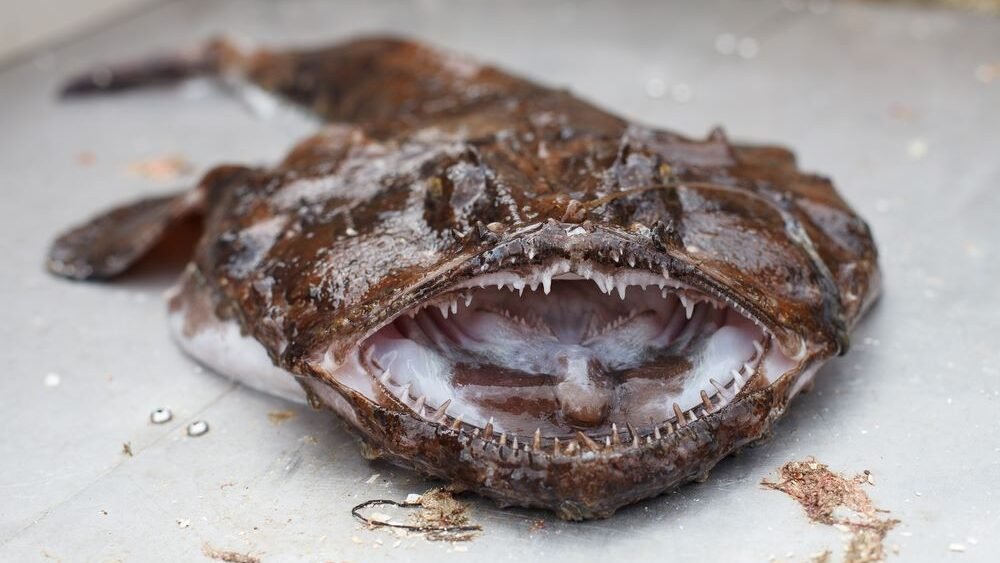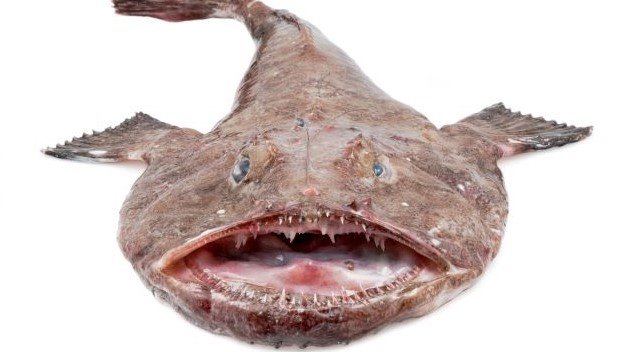Deep-Sea Anglerfish: Fun Facts, Habitat, Behavior & Light Lure
Have you ever heard of anglerfish? It’s a mysterious deep-sea dweller with a huge mouth and a creepy light on its head that leave other fish speechless. This article will dive into everything you need to know about deep-sea anglerfishes. By the end of it, you’ll be the angler fish expert in your friends’ group, so let’s begin with some quick, interesting, fun facts.
Quick, Interesting, Fun Facts about Deep-Sea Anglerfish
- Order of deep-sea predators known for bizarre appearance, sharp fangs, & bioluminescent lure
- The lure is a modified spine from the dorsal fin.
- Over 200 documented species spread across 11 families
- Some species can change colors to match the environment.
- Well-known types include Humpback, Frogfish, Monkfish, & Aquatic.
- The liver of monkfish is a delicacy in Japan.
- In northern Europe, monkfish are commercially fished.
- There are significant sex differences, with smaller males, and the males may lack a lure.
- They eat crustaceans and fish.
- Their reproduction methods are external fertilization and an entirely symbiotic relationship.
- Not common in fishing, but considered a delicacy in some areas
- Found all over the world in deep tropical & temperate waters
- Not all species are blind but have specialized eyes for deep-sea habitats.
- They may seem scary due to their sharp fangs & appearance, but they are not dangerous to humans.
What are Angler Fish (Lophiiformes)? Characteristics and Anatomy

- Anglerfish are carnivorous and come in different colors, mainly dark gray to dark brown.
- Deep-sea species have large heads with crescent-shaped mouths and fang-like teeth.
- Sexual dimorphism results in female anglerfish being much larger than males.
- Frogfish and shallow-water species are ambush predators and are often camouflaged.
- Most adult female ceratioid anglerfish have a luminescent organ called the esca that serves as bait and attracts males for mating.
- Symbiotic bacteria living in the esca, enclosed in a cup-shaped reflector, produce light in the lure.
- The bacteria are Gram-negative rods without fragments or flagella and have a pore connecting to the seawater.
- The light gland is always open to the exterior, and the anglerfish may acquire the bacteria from the seawater.
- The genetic material of the symbiont bacteria is found near the anglerfish, indicating a symbiotic relationship.
- In a study, the anglerfish in the Gulf of Mexico likely acquired their symbionts from the seawater.
- The symbiont genomes are reduced in size and contain many pseudogenes.
- The anglerfish’s wide mouth has inwardly inclined teeth that can prevent prey from escaping.
- The anglerfish can distend its jaw and stomach to swallow prey larger than its body.
- Length varies between species, some are 2-18 cm, and a few are up to 100 cm in length.
- Weight is 2-44 lbs and varies by species and sex, with females often larger.
- The largest fish of the species ever caught was 88 lbs.
- Lifespan is roughly 10-15 years, but some can live up to 30 years.
Habitat
Anglerfish species are either benthic and live near the ocean floor or pelagic, and stay away from the sea floor. Some species have their habitat on the continental shelf, and others live in deep-sea waters.
Most species live in deep, cold, and dark waters of the Atlantic, Mediterranian, Antarctica, and Indian oceans, with a few living in shallower and warmer environments.
Behavior

Scientists, using a remotely operated vehicle to dive deep, have observed anglerfish up close and seen them beating their pectoral fins in cycles and swimming in between. They have seen a whipnose anglerfish float inverted and completely still near other prey fish to lure them.
Most deep sea fish are foragers or scavengers, and deep sea anglerfish are opportunistic and can eat many types of prey but seem to favor some types over others. Anglerfish can extend their stomachs and jaws to eat prey twice their size and have room to store food, and it’s similar to how a snake can expand its jaws to swallow larger prey animals.
Regarding mating, the different species of anglerfishes have different systems. The ceratioid species’ female has an organ called esca located on its dorsal ray tip, acting as bait, but also attracts males for mating. In some species, the male is much smaller than the female and attaches to them with a fuse to reproduce. Other species have terrible eyesight and rely on an olfactory organ to detect potential mates.
The Angler Fish’s Unique Light Lure
The anglerfish’s most unique trait is its light lure that grows out of its forehead and looks like an antenna in front of its head. The light lure is a luminescent fin ray, also known as an illicium or esca, and its light source is symbiotic bacteria that scientists believe the fish gathers from the ocean. The sub-species Bufoceratias wedli have two lures on its back, one smaller and one longer. The anglerfish uses its lure as a fishing rod to attract prey such as small fish and squid. The process by which the fish produces light by itself is called bioluminescent, and other fish that use bioluminescent to lure prey is the lantern fish.
European Angler vs. Monkfish vs. Goosefish vs. Blackbellied Angler

Not all subspecies are the same. The European angler (Lophius piscatorius), also known as the common monkfish, is one monkfish living in the northeast Atlantic Ocean. Monkfish (Lophius) is a genus of species, often called monk, frog-fish, sea-devils, or fishing-frogs, and they live in the Indian and Atlantic Oceans. There is confusion about the word “monkfish” as the same word is used to refer to a type of shark (angelshark).
A blackbellied angler (Lophius budegassa) lives in depths of 300 to 1000 meters in parts of the Mediterranian Sea and in the waters around the United Kingdom at depths of 650 meters. It also lives in some places along the coast of Africa. Its average length is around 30 centimeters, but it can grow up to 1 meter.
A goosefish is another species in the same genus that lives in the Pacific, Arctic, Indian and Atlantic oceans and prefers the ocean floor of either sand or mud at depths of more than 1000 meters. Scientists have observed some goosefish growing up to 1.5 meters in length.
Anglerfish Scientific Classification
There are over 200 species of anglerfish that have evolved from about 130 to 100 million years ago, and the scientific classification is as follows:
- Kingdom: Animalia
- Phylum: Chordata
- Class: Actinopterygii
- Clade: Percomorpha
- Order: Lophiiformes
- Species: Lophius piscatorius
Suborder classifications by taxonomy:
- Lophoiodei
- Lophiidae (goosefish, monkfish)
- Antennarioidei
- Antennariidae (frogfish)
- Tetrabrachiidae (four-armed frogfish)
- Brachionichthyidae (handfish)
- Lophichthyidae (Boschma’s frogfish)
- Chaunacoidei
- Chaunacidae (sea toads)
- Ogcocephaloidei
- Ogcocephalidae (batfishes)
- Ceratioidei
- Centrophrynidae (prickly seadevil)
- Ceratiidae (warty seadevil)
- Himantolophidae (footballfish)
- Diceratiidae (doublespine seadevil)
- Melanocetidae (black seadevil)
- Thaumatichthyidae (wolf-trap seadevil)
- Oneirodidae (dreamer)
- Caulophrynidae (fanfic seadevil)
- Neoceratiidae (needlebeard seadevil)
- Gigantactinidae (whipnose seadevil)
- Linophrynidae (leftvent seadevil)
Read more about it here.
Conclusion
Deep-sea anglerfish are unique and mysterious animals that use bioluminescence to light up their lure fin to entice prey and then hunt them with their sharp teeth. There are many species of luminous deep-sea anglers, such as the monkfish and European angler, and biologists still need more opportunities to study and explore these species.

